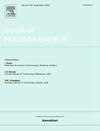新疆中部湖池超晚叠统岩石的自然放射性及其放射性危害
IF 2.3
3区 工程技术
Q1 NUCLEAR SCIENCE & TECHNOLOGY
引用次数: 0
摘要
原始放射性核素(226Ra, 232Th, 40K)是自然辐射的主要贡献者,并倾向于集中在地壳的特定岩性中。本研究调查了来自本文章由计算机程序翻译,如有差异,请以英文原文为准。
Natural radioactivity and radiological hazards in ultrapotassic rocks from the Central Pontides, Türkiye
Primordial radionuclides (226Ra, 232Th, 40K) are key contributors to natural radiation and tend to concentrate in specific lithologies in the Earth’s crust. This study investigates Upper Cretaceous ultrapotassic rocks from the Central Pontides in Türkiye, where increasing constructional and industrial activities raise concerns about radiological exposure and environmental health risks. Gamma spectrometry analysis of powdered rock samples reveals that 226Ra (10.0–53.6 Bq/kg) and 232Th (9.3–65 Bq/kg) generally fall below global averages, whereas 40K reaches notably high levels (97–1940 Bq/kg). Elevated 40K levels in trachytic, leucite-bearing, and lamprophyric rocks from Amasya, Tosya, and Kalecik, result in radiological hazard parameters exceeding recommended limits, despite relatively modest 226Ra and 232Th activities. Correlation analyses indicate moderate relationships between 226Ra and 232Th, but weak correlations with 40K, suggesting post-magmatic processes possibly influenced these rocks. These findings underscore the importance of ultra- and high-potassic rocks as potential gamma radiation sources in areas where land use, construction, and dust or soil mobilization increase interactions with biological organisms. Continuous monitoring of potassium-40 pathways and the proper management strategies are critical to mitigate possible health risks associated with elevated radionuclide concentrations.
求助全文
通过发布文献求助,成功后即可免费获取论文全文。
去求助
来源期刊

Annals of Nuclear Energy
工程技术-核科学技术
CiteScore
4.30
自引率
21.10%
发文量
632
审稿时长
7.3 months
期刊介绍:
Annals of Nuclear Energy provides an international medium for the communication of original research, ideas and developments in all areas of the field of nuclear energy science and technology. Its scope embraces nuclear fuel reserves, fuel cycles and cost, materials, processing, system and component technology (fission only), design and optimization, direct conversion of nuclear energy sources, environmental control, reactor physics, heat transfer and fluid dynamics, structural analysis, fuel management, future developments, nuclear fuel and safety, nuclear aerosol, neutron physics, computer technology (both software and hardware), risk assessment, radioactive waste disposal and reactor thermal hydraulics. Papers submitted to Annals need to demonstrate a clear link to nuclear power generation/nuclear engineering. Papers which deal with pure nuclear physics, pure health physics, imaging, or attenuation and shielding properties of concretes and various geological materials are not within the scope of the journal. Also, papers that deal with policy or economics are not within the scope of the journal.
 求助内容:
求助内容: 应助结果提醒方式:
应助结果提醒方式:


